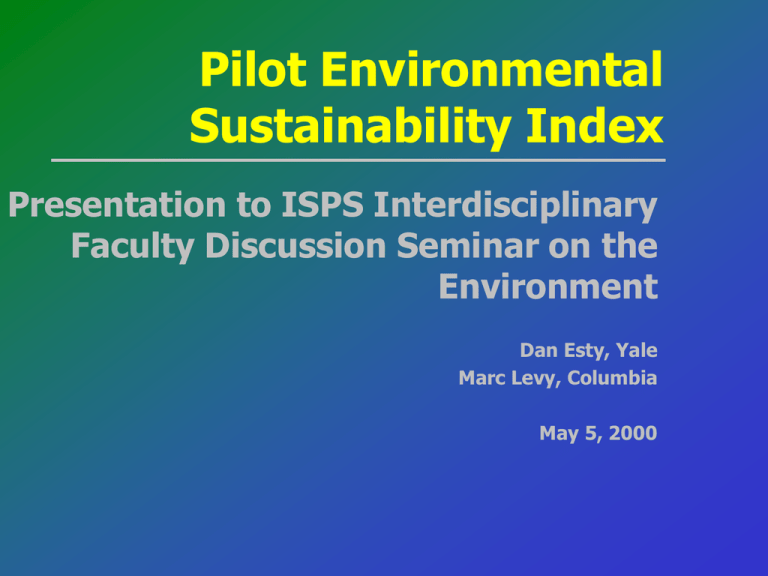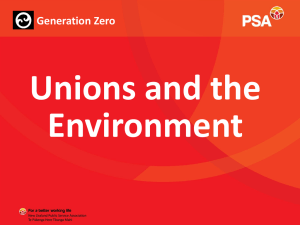Pilot Environmental Sustainability Index
advertisement

Pilot Environmental Sustainability Index Presentation to ISPS Interdisciplinary Faculty Discussion Seminar on the Environment Dan Esty, Yale Marc Levy, Columbia May 5, 2000 The Environmental Sustainability Index is the result of a partnership involving: • Global Leaders for Tomorrow Environment Task Force, World Economic Forum (Kim Samuel-Johnson, Chair) • Yale Center for Environmental Law and Policy (YCELP), Yale University (Dan Esty) • Center for International Earth Science Information Network (CIESIN), Columbia University (Marc Levy) The report can be obtained at these web sites: • http://www.ciesin.org/indicators/ESI/pilot_esi.html • http://www.yale.edu/envirocenter/research/esi.html • http://weforum.com/pdf/glt/glt_esi_2000.pdf The Need for an Environmental Sustainability Index • Counterpart to Competitiveness ndex and other economic performance measures • Benchmark environmental performance • Better goals, programs, and policies • Clarify environment/economic tradeoffs Pilot ESI Builds on Work of: • OECD • UN Commission on Sustainable Development • Consultative Group on Sustainable Development Indicators • Numerous other local, national, and international efforts Our Objectives • Create an index that: – Provides comparability across a wide range of countries – Focuses on environmental aspects of sustainability – Expresses results as a single number per economy, but permits more sophisticated disaggregation and analysis – Builds on an analytic foundation – Serves as a working prototype meant to encourage debate, dialogue, learning Preliminary Results Pilot Environmental Sustainability Index (v. 1.1) Norway Finland Switzerland Iceland Sweden Denmark Canada New Zealand Australia Netherlands Ireland Japan France United States Austria Slovak Rep United Kingdom Germany Argentina Belgium Uruguay Portugal Spain Israel Russian Federation Lithuania, Rep Hungary Brazil Paraguay Poland, Rep Chile Italy Venezuela Ecuador Costa Rica Bolivia Botswana Cuba Czech Rep M ongolia Greece Colombia Ukraine Nepal M alaysia Korea, Rep Thailand M exico Indonesia Philippines Jordan India M orocco South Africa Gabon Romania Ghana China M ali Bulgaria El Salvador Egypt Turkey Guatemala Zimbabwe Algeria Tunisia Nicaragua Pakistan M auritius Peru Cameroon Sri Lanka Kenya M oldova, Rep Senegal Zambia Honduras Singapore Iran, Islamic Rep Vietnam Bangladesh M alawi Nigeria Tanzania M adagascar Uganda Top quintile 2nd quintile 3rd quintile 4th quintile 5th quintile •Australia •Argentina •Botswana •Algeria •Bangladesh •Austria •Belgium •Colombia •Bulgaria •Cameroon •Canada •Bolivia •Cuba •China •Honduras •Denmark •Brazil •Czech Rep •Egypt •Iran •Finland •Chile •Greece •El Salvador •Kenya •France •Costa Rica •India •Gabon •Madagascar •Germany •Ecuador •Indonesia •Ghana •Malawi •Iceland •Hungary •Jordan •Guatemala •Moldova •Ireland •Israel •Korea, Rep •Mali •Nigeria •Japan •Italy •Malaysia •Mauritius •Peru •Netherlands •Lithuania, Rep •Mexico •Nicaragua •Senegal •New Zealand •Paraguay •Mongolia •Pakistan •Singapore •Norway •Poland, Rep •Morocco •Romania •Sri Lanka •Slovak Rep •Portugal •Nepal •South Africa •Tanzania •Sweden •Russian Federation •Philippines •Tunisia •Uganda •Switzerland •Spain •Thailand •Turkey •Vietnam •United Kingdom •Uruguay •Ukraine •Zimbabwe •Zambia •United States •Venezuela 0 20 40 60 80 100 High numbers correspond to greater levels of environmental sustainability Analytical Foundations Environmental Systems • • • • • Urban Air Quality Water Quantity Water Quality Biodiversity Land Social and Institutional Capacity Human Vulnerability • Basic Sustenance • Public Health • Environmental Disasters Environmental Stresses • • • • • • Science/Technical Capacity • Rigorous Policy Debate • Environmental Regulation and Management • Tracking Environmental Conditions • Eco-efficiency • Public Choice Failures Air Pollution Water Pollution/Use Ecosystem Stress Waste/Consumption Population Global Stewardship • Contribution to International Cooperation • Impact on Global Commons Empirical Inputs • For each factor, we identified 1-6 variables to serve as quantitative measures (65 total) • For this pilot, we weighted the factors equally in computing the Index 65 variables 21 factors 5 components Index Example: Social and Institutional Capacity Austria Brazil Costa Rica Egypt France Malaysia Portugal Switzerland Turkey Ukraine 0 10 20 30 40 50 60 70 Scientific and Technical Capacity Capacity for Rigorous Public Debate Environmental Regulation and Management Tracking Environmental Conditions Eco-efficiency Avoiding Public Choice Failures 80 Example: Social and Institutional Capacity Switzerland Austria France Portugal Costa Rica Brazil Turkey Malaysia Egypt Ukraine 0 10 20 30 40 50 60 70 Scientific and Technical Capacity Capacity for Rigorous Public Debate Environmental Regulation and Management Tracking Environmental Conditions Eco-efficiency Avoiding Public Choice Failures 80 Example: Social and Institutional Capacity Figure 9. Social and Institutional Capacity Component Swit zerland Net herlands Sweden Finland Denmark Norway Aust ria Unit ed Kingdom Germany Israel Iceland New Zealand France Aust ralia Canada Japan Unit ed St at es Belgium Port ugal Ireland Singapore Spain Korea It aly Cost a Rica Chile Maurit ius Argent ina Sout h Af rica Slovak Republic Brazil Thailand Jordan El Salvador Hungary Poland Turkey Czech Republic Ecuador Peru Zimbabwe Greece Malaysia Philippines India Mexico Indonesia Bolivia Egypt Venezuela Russia China Bulgaria Colombia Ukraine Viet nam Scientific and Technical Capacity Capacity for Rigorous Public Debate Environmental Regulation and Management Tracking Environmental Conditions Eco-efficiency Avoiding Public Choice Failures 0 20 40 60 Longer bar s denot e gr eat er l evel s of capaci t y 80 100 Putting the Index to Use: Assessing Environment/Economic Tradeoffs As hypothesized Environmental by Michael sustainability Porter, there does not appear be aa tomay impose connection constraint on between good economic economic growth performance and good environmental performance Relationship between Environmental Sustainability and Relationship between Environmental Sustainability Economic Growth, 1993-1998 80 80 and Economic Competitiveness 70 70 60 60 50 50 40 40 -15 -3 -2 -10 -1 -5 0 0 1 GDP Rate, 1993-1998 WEF Growth Competitiveness Index 52 310 Among Similar Economies the Importance of Choice is Clear How vigorously to pursue environmental sustainability, and how vigorously to pursue economic growth, appear to be two separate choices Why does this matter? Four perspectives on the relationship between economic performance and environmental sustainability Environment Difficult tradeoffs – policy dilemmas Environmental Kuznets: just be patient Economics Good things go together – policy “free lunch” All combinations are possible – importance of responsible policy choices Good indicators are vital Conclusions (Does the world really need another environmental indicator?) • Measuring environmental sustainability is possible and useful – This is a surprising, and encouraging, result • Some aspects appear to be easier to quantify than others – Some surprises here (capacity v. stress) • A future ESI can improve on the Pilot Conclusions – Investment in data creation • Most global environmental monitoring programs are based on 19th century models – time to move forward – Pluralistic, distributed networks (no central bottlenecks) – Greater use of civil society – Remote sensing and other advanced technologies – More sophisticated methods to weight factors and test validity, understand underlying assumptions and values • Factor analysis, time series analysis, regression analysis – Interactive, open version • Permit users to change factors and variables, change weights, add new variables – Scalable version • Permit users to integrate global, national, regional and local indicators as appropriate to their needs Project Status • Pilot – Pilot Index presented in Davos 1-31-00 – Detailed peer-reviewed critiques prepared February-April, 2000 – Presentations to various policy and academic fora – Detailed review within several organizations and governments • 2001 Index – Reviewing results of peer reviews and other commentary – Planning refinements in methods, improvements in data, expansion of country coverage. – Considering devoting special effort to a particular sector (e.g. water) – To be released January 2001 Payoff – Strengthen quality of scholarly debates and research programs – Enhance assessment of national environmental performance – greater accountability – Improve formulation of policy targets and priorities (identifying critical weaknesses)







